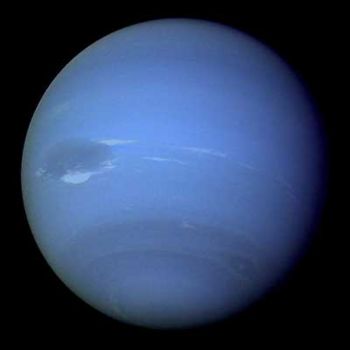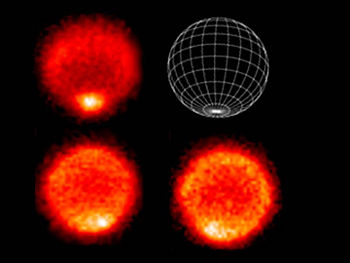Neptune (planet): Difference between revisions
imported>Trevor Ebbens |
mNo edit summary |
||
| (10 intermediate revisions by 5 users not shown) | |||
| Line 1: | Line 1: | ||
{{subpages}} | {{subpages}} | ||
'''Neptune''' is the eighth [[planet]] from the [[Sun]] in our [[Solar system|solar system]]. | {{dambigbox|Neptune (planet)|Neptune}} | ||
'''Neptune''' is the eighth [[planet]] from the [[Sun]] in our [[Solar system|solar system]]. Along with [[Uranus_(planet)|Uranus]], it is classified as an icy giant. ([[Jupiter_(planet)|Jupiter]] and [[Saturn_(planet)|Saturn]] are classified as [[gas giant]]s.) | |||
{{Image|Neptune NASA-JPL.jpg|right|350px|Voyager 2 photo of Neptune taken in 1989}} | {{Image|Neptune NASA-JPL.jpg|right|350px|Voyager 2 photo of Neptune taken in 1989}} | ||
| Line 7: | Line 8: | ||
Neptune is approximately 4.5 billion kilometers <ref>2.8 billion miles</ref> from the Sun which it orbits once every 165 years. It is invisible to the unaided eye because of its distance.<ref name=NASASSENeptune/> | Neptune is approximately 4.5 billion kilometers <ref>2.8 billion miles</ref> from the Sun which it orbits once every 165 years. It is invisible to the unaided eye because of its distance.<ref name=NASASSENeptune/> | ||
Every 248 years, for a period of 20 years, the orbit of Pluto lies within the orbit of Neptune | Every 248 years, for a period of 20 years, the orbit of [[Pluto (dwarf planet)|Pluto]] lies within the orbit of Neptune.<ref name=NASASSENeptune/> | ||
==Parameters for classification as a planet== | ==Parameters for classification as a planet== | ||
Neptune is classified as a planet by the International Astronomical Union for meeting the following criteria:<ref>[http://www.nasa.gov/vision/universe/solarsystem/planetsf-20060824.html Honey, I Shrunk the Solar System] NASA. “The International Astronomical Union has decided that, to be called a planet, an object must have three traits. It must orbit the Sun, be massive enough that its own gravity pulls it into a nearly round shape, and be dominant enough to clear away objects in its neighborhood.”</ref> | Neptune is classified as a planet by the International Astronomical Union for meeting the following criteria:<ref>[http://www.nasa.gov/vision/universe/solarsystem/planetsf-20060824.html Honey, I Shrunk the Solar System] NASA. “The International Astronomical Union has decided that, to be called a planet, an object must have three traits. It must orbit the Sun, be massive enough that its own gravity pulls it into a nearly round shape, and be dominant enough to clear away objects in its neighborhood.”</ref> | ||
*Orbits the | *Orbits the Sun; | ||
*Has mass sufficient for its gravity to form a nearly round shape; | *Has mass sufficient for its gravity to form a nearly round shape; | ||
*Has mass sufficient for gravity to clear a path in its orbit. | *Has mass sufficient for gravity to clear a path in its orbit. | ||
==Physical characteristics== | ==Physical characteristics== | ||
Neptune is approximately 30 times as far from the | Neptune is approximately 30 times as far from the Sun as Earth (30 AU). Though slightly smaller than Uranus, it is more dense and is about seventeen times more massive than Earth (17 Earth masses). At its distance from the Sun, it receives about one thousandth of the same sunlight as Earth.<ref name= NeptuneSouthPole>[http://www.nasa.gov/vision/universe/solarsystem/neptune-20070918.html A warm south pole on Neptune] NASA 18/09/07. Retrieved 4/11/07</ref> It radiates more internal heat than it receives from the Sun, though less than Jupiter or Saturn, indicating a radioactive inner core.<ref>{{cite web|title=Post Voyager comparisons of the interiors of Uranus and Neptune|author=Podolak, M.; Reynolds, R. T.; Young, R.|work=NASA, Ames Research Center|year=1990|url=http://adsabs.harvard.edu/abs/1990GeoRL..17.1737P|accessdate= 2006-01-16 }}</ref> | ||
{{Image|Thermal images of Neptune's polar region.jpg|right|350px|ESO Very Large Telescope thermal images of Neptune's south polar region showing variation in temperature.}} | {{Image|Thermal images of Neptune's polar region.jpg|right|350px|ESO Very Large Telescope thermal images of Neptune's south polar region showing variation in temperature.}} | ||
The average temperature on Neptune is -200° C (392° F). Recent measurements have shown the southern pole to be about 10° C hotter than the planet's average. This results in the vaporisation of the frozen methane and its circulation to the upper layers of the atmosphere. Neptune is comprised predominantly of hydrogen and helium. However, its methane component reaches the upper atmosphere absorbing red light from sunlight | The average temperature on Neptune is -200° C (-392° F). Recent measurements have shown the southern pole to be about 10° C hotter than the planet's average. This results in the vaporisation of the frozen methane and its circulation to the upper layers of the atmosphere. Neptune is comprised predominantly of hydrogen and helium. However, its methane component reaches the upper atmosphere absorbing red light from sunlight and reflects the blue spectrum making Neptune appear blue.<ref name= NeptuneSouthPole/><ref>Methane red-light absorption and blue-green reflection also gives [[Uranus (planet)]] its blue-green colour</ref> | ||
==Rotational characteristics== | ==Rotational characteristics== | ||
| Line 29: | Line 30: | ||
==Natural satellites== | ==Natural satellites== | ||
Neptune has thirteen moons. The largest, [[Triton (moon)|Triton]], is geologically active, with geysers of [[liquid nitrogen]].<ref>{{cite web|title=The Plausibility of Boiling Geysers on Triton|author=Duxbury, N.S., Brown, R.H.|work=Beacon eSpace|year=1995|url=http://trs-new.jpl.nasa.gov/dspace/handle/2014/28034?mode=full|accessdate= 2006-01-16 }}</ref> {{Image|362894main image 1396 946-710.jpg|right|550px|"Triton | Neptune has thirteen moons. The largest, [[Triton (moon)|Triton]], is geologically active, with geysers of [[liquid nitrogen]].<ref>{{cite web|title=The Plausibility of Boiling Geysers on Triton|author=Duxbury, N.S., Brown, R.H.|work=Beacon eSpace|year=1995|url=http://trs-new.jpl.nasa.gov/dspace/handle/2014/28034?mode=full|accessdate= 2006-01-16 }}</ref> {{Image|362894main image 1396 946-710.jpg|right|550px|"Triton | ||
Color photo of Neptune's moon Triton on | Color photo of Neptune's moon Triton on August 24 1989, at a range of 330,000 miles by Voyager 2 spacecraft using green, violet and ultraviolet filters.The regions that are highly reflective in the ultraviolet appear blue in color. In reality, there is no part of Triton that would appear blue to the eye. The bright southern hemisphere of Triton, which fills most of this frame, is generally pink in tone, as is the even brighter equatorial band. The darker regions north of the equator also tend to be pink or reddish in color."<ref>Triton[http://www.nasa.gov/multimedia/imagegallery/image_feature_1396.html]</ref>}}Triton is the only large satellite with a [[Retrograde and direct motion|retrograde]] orbit. Neptune possesses a number of [[Neptune Trojan|Trojan asteroid]]s. | ||
*Triton | *Triton | ||
| Line 45: | Line 46: | ||
*Neso | *Neso | ||
<ref name=NASASSENeptune/> | <ref name=NASASSENeptune/> | ||
==References== | ==References== | ||
{{reflist}} | {{reflist}}[[Category:Suggestion Bot Tag]] | ||
Latest revision as of 16:00, 24 September 2024
Neptune is the eighth planet from the Sun in our solar system. Along with Uranus, it is classified as an icy giant. (Jupiter and Saturn are classified as gas giants.)
Neptune is the first planet predicted through indirect observation and mathematical deduction, although Galileo did record it as a fixed star in 1612 and 1613. Aberrations in the orbit of Uranus led French mathematician and astronomer Urbain Joseph Le Verrier to propose influence by an unknown planet whose mass and position would effect it. His proposals were ignored until Johann Gottfried Galle at the Berlin Observatory found Neptune the first night he began searching for it in 1846.[1]
Neptune is approximately 4.5 billion kilometers [2] from the Sun which it orbits once every 165 years. It is invisible to the unaided eye because of its distance.[1]
Every 248 years, for a period of 20 years, the orbit of Pluto lies within the orbit of Neptune.[1]
Parameters for classification as a planet
Neptune is classified as a planet by the International Astronomical Union for meeting the following criteria:[3]
- Orbits the Sun;
- Has mass sufficient for its gravity to form a nearly round shape;
- Has mass sufficient for gravity to clear a path in its orbit.
Physical characteristics
Neptune is approximately 30 times as far from the Sun as Earth (30 AU). Though slightly smaller than Uranus, it is more dense and is about seventeen times more massive than Earth (17 Earth masses). At its distance from the Sun, it receives about one thousandth of the same sunlight as Earth.[4] It radiates more internal heat than it receives from the Sun, though less than Jupiter or Saturn, indicating a radioactive inner core.[5]
The average temperature on Neptune is -200° C (-392° F). Recent measurements have shown the southern pole to be about 10° C hotter than the planet's average. This results in the vaporisation of the frozen methane and its circulation to the upper layers of the atmosphere. Neptune is comprised predominantly of hydrogen and helium. However, its methane component reaches the upper atmosphere absorbing red light from sunlight and reflects the blue spectrum making Neptune appear blue.[4][6]
Rotational characteristics
Neptune’s polar orientation is similar to Earth’s with the northern pole tilting toward or away from the Sun in season. The northern hemisphere summers and winters lasts approximately 40 years each. The variation in polar tilts and increased temperature may be a contributing factor to the winds on Neptune which reach velocities of about 2,000 k/h (1,240 m/h)[4]
Orbital characteristics
Neptune has an orbital period (sidereal year) of 164.79 earth years. At is closest approach to the Sun (perihelion) it is nearly 30 times the distance of the Earth from the Sun (29.80 AU). At its furthest distance from the Sun (aphelion) it is 30.32 AU from the Sun.[7]
Natural satellites
Neptune has thirteen moons. The largest, Triton, is geologically active, with geysers of liquid nitrogen.[8]

Triton is the only large satellite with a retrograde orbit. Neptune possesses a number of Trojan asteroids.
- Triton
- Nereid
- Naiad
- Thalassa
- Despina
- Galatea
- Larissa
- Proteus
- Halimede
- Psamathe
- Sao
- Laomedeia
- Neso
References
- ↑ 1.0 1.1 1.2 1.3 Neptune NASA
- ↑ 2.8 billion miles
- ↑ Honey, I Shrunk the Solar System NASA. “The International Astronomical Union has decided that, to be called a planet, an object must have three traits. It must orbit the Sun, be massive enough that its own gravity pulls it into a nearly round shape, and be dominant enough to clear away objects in its neighborhood.”
- ↑ 4.0 4.1 4.2 A warm south pole on Neptune NASA 18/09/07. Retrieved 4/11/07
- ↑ Podolak, M.; Reynolds, R. T.; Young, R. (1990). Post Voyager comparisons of the interiors of Uranus and Neptune. NASA, Ames Research Center. Retrieved on 2006-01-16.
- ↑ Methane red-light absorption and blue-green reflection also gives Uranus (planet) its blue-green colour
- ↑ The orbits of the planets National Maritime Museum
- ↑ Duxbury, N.S., Brown, R.H. (1995). The Plausibility of Boiling Geysers on Triton. Beacon eSpace. Retrieved on 2006-01-16.
- ↑ Triton[1]

